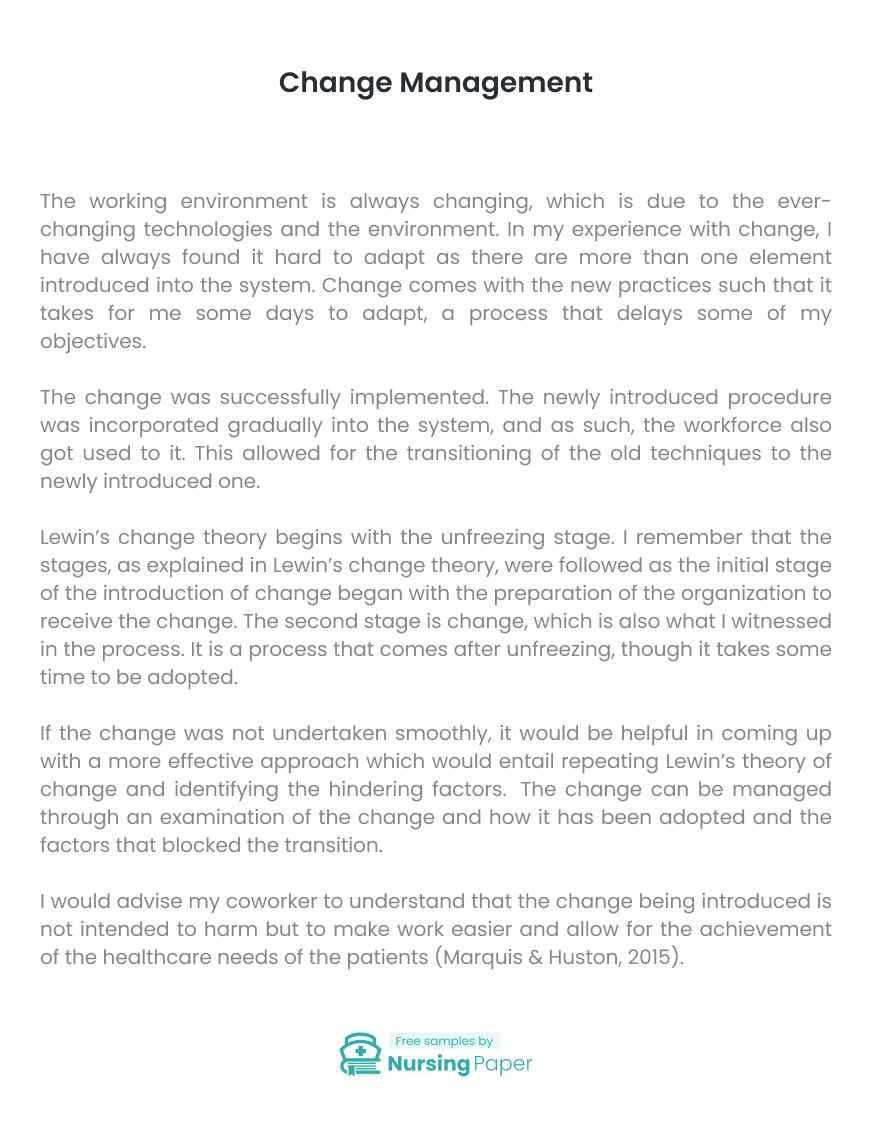
Change Management
Introduction
The working environment is always changing, which is due to the ever-changing technologies and the environment. In my experience with change, I have always found it hard to adapt as there are more than one element introduced into the system. Change comes with the new practices such that it takes for me some days to adapt, a process that delays some of my objectives.
The change was successfully implemented. The newly introduced procedure was incorporated gradually into the system, and as such, the workforce also got used to it. This allowed for the transitioning of the old techniques to the newly introduced one.


Lewin’s change theory begins with the unfreezing stage. I remember that the stages, as explained in Lewin’s change theory, were followed as the initial stage of the introduction of change began with the preparation of the organization to receive the change. The second stage is change, which is also what I witnessed in the process. It is a process that comes after unfreezing, though it takes some time to be adopted.
If the change was not undertaken smoothly, it would be helpful in coming up with a more effective approach which would entail repeating Lewin’s theory of change and identifying the hindering factors. The change can be managed through an examination of the change and how it has been adopted and the factors that blocked the transition.
I would advise my coworker to understand that the change being introduced is not intended to harm but to make work easier and allow for the achievement of the healthcare needs of the patients (Marquis & Huston, 2015). In addition, I would explain to him or her why the need for a change is requisite, as there are many other factors that have changed, hence a need to adapt.

1. Marquis, B. L., & Huston, C. J. (2015). Leadership roles and management functions in nursing: Theory and application (8th ed.). Lippincott Williams & Wilkins.



The download will start shortly.

The download will start shortly.
 Subject:
Nursing
Subject:
Nursing  Number of pages: 5
Number of pages: 5  Subject:
Health and Social Care
Subject:
Health and Social Care  Number of pages: 10
Number of pages: 10  Subject:
Medicine
Subject:
Medicine  Number of pages: 2
Number of pages: 2  Subject:
Nursing
Subject:
Nursing  Number of pages: 8
Number of pages: 8  Subject:
Health and Social Care
Subject:
Health and Social Care  Number of pages: 8
Number of pages: 8  Subject:
Medicine
Subject:
Medicine  Number of pages: 3
Number of pages: 3  Subject:
Medicine
Subject:
Medicine  Number of pages: 1
Number of pages: 1  Subject:
Medicine
Subject:
Medicine  Number of pages: 6
Number of pages: 6  Subject:
Health and Social Care
Subject:
Health and Social Care  Number of pages: 4
Number of pages: 4  Subject:
Nursing
Subject:
Nursing  Number of pages: 4
Number of pages: 4  Subject:
Medicine
Subject:
Medicine  Number of pages: 7
Number of pages: 7  Subject:
Nursing
Subject:
Nursing  Number of pages: 4
Number of pages: 4  Subject:
Medicine
Subject:
Medicine  Number of pages: 2
Number of pages: 2  Subject:
Nursing
Subject:
Nursing  Number of pages: 7
Number of pages: 7 
